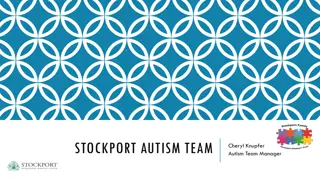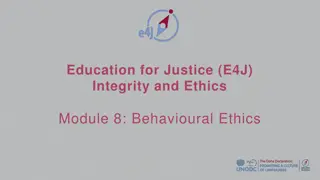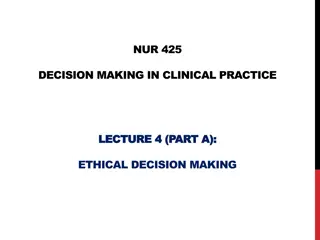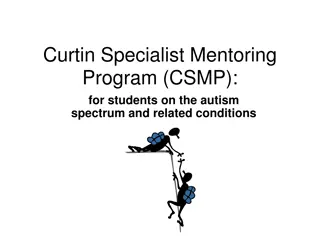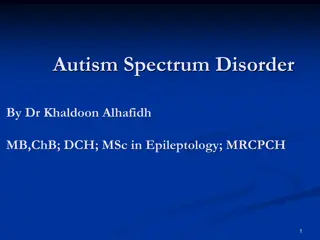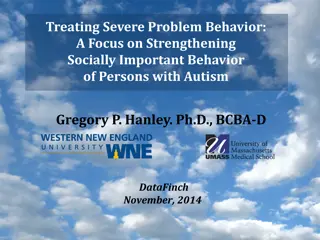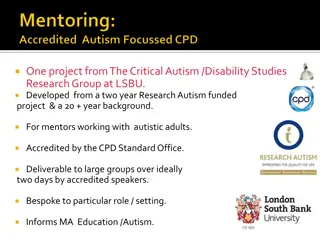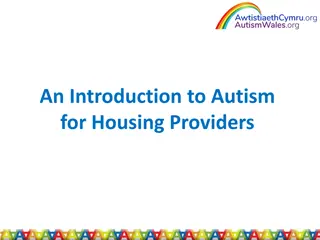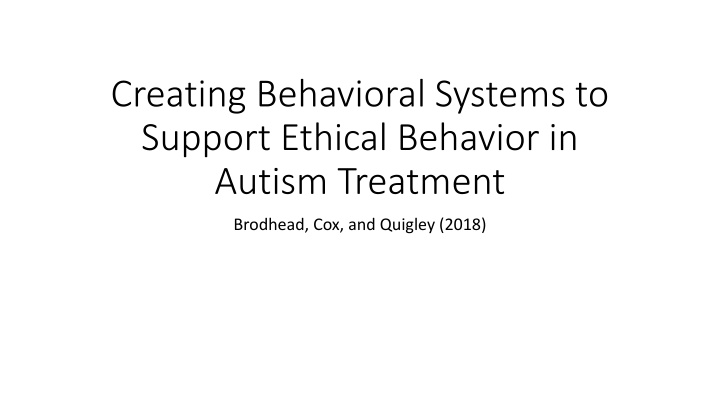
Implementing Behavioral Systems Analysis in Autism Treatment
Explore the importance of Behavioral Systems Analysis in promoting ethical behavior within autism treatment. Learn how it aligns with the BACB Ethics Code and provides tools to ensure practitioners adhere to ethical standards across various settings and cultures.
Download Presentation

Please find below an Image/Link to download the presentation.
The content on the website is provided AS IS for your information and personal use only. It may not be sold, licensed, or shared on other websites without obtaining consent from the author. If you encounter any issues during the download, it is possible that the publisher has removed the file from their server.
You are allowed to download the files provided on this website for personal or commercial use, subject to the condition that they are used lawfully. All files are the property of their respective owners.
The content on the website is provided AS IS for your information and personal use only. It may not be sold, licensed, or shared on other websites without obtaining consent from the author.
E N D
Presentation Transcript
Creating Behavioral Systems to Support Ethical Behavior in Autism Treatment Brodhead, Cox, and Quigley (2018)
Chapter Overview Behavioral systems analysis and the BACB Ethics Code A brief introduction to behavioral systems analysis Six steps of behavioral systems analysis Case examples of behavioral systems analysis
Behavioral Systems Analysis and the BACB Ethics Code
Behavioral Systems Analysis and the BACB Ethics Code Behavior analytic services are delivered across many settings, communities, and cultures The application of the BACB Ethical and Compliance Code is likely to be different across settings, communities, and cultures There are few to no published behavior analytic resources that describe how settings, communities, and cultures may influence ethical behavior of behavior analysts
Behavioral Systems Analysis and the BACB Ethics Code Knowing and understanding an ethical code does not ensure ethical behavior If the BACB Code were effective in isolation, unethical behavior would not occur Ethical behavior must be taught, like other classes of behavior Behavioral systems analysis may provide the tools to align practitioner behavior with the BACB Code across settings, communities, and cultures
A Brief Introduction to Behavioral Systems Analysis
Behavioral Systems Analysis Introduction System An organized, integrated, unified set of components, accomplishing a particular set of ultimate goals or objectives (Malott & Garcia, 1987, p. 127) Systems are purposeful and include processes that describe observable behavior Community-based autism services designed to improve social interactions Functional analysis of self-injury (Iwata, Dorsey, Slifer, Bauman, & Richman, 1982/1994)
Behavioral Systems Analysis Introduction Behavioral system A system that involves human behavior (Malott & Garcia, 1987) Ethics behavioral system One or more individuals work to accomplish goals related to ethical behavior When collaborating with teachers in a public-school setting, the behavior analyst will respect the values and opinions of interdisciplinary professionals
Behavioral Systems Analysis Introduction Behavioral systems analysis The design, evaluation, and modification of systems to help [organizations] accomplish their objectives (Malott & Garcia, 1987, p. 133) A series of behaviors that allow organizations to Identify deficits in the ethical behavior of its employees Develop systems to meet goals / objectives Analyze outcomes to improve ethical behavior
Six Steps of Behavioral Systems Analysis
Six Steps of Behavioral Systems Analysis Analyze Evaluation of natural contingencies Identify variables that hinder desired performance / maintain undesired performance The Performance Diagnostic Checklist Human Services (PDC-HS; Carr et al., 2013) is a useful tool
Six Steps of Behavioral Systems Analysis Specify Describe the desired performance objectives and goals Descriptions should be observable and measurable, and should be accomplishments
Six Steps of Behavioral Systems Analysis Design This is the phase where the BCBA describes the intervention procedures that will bring about behavior change The intervention should be based upon the analysis and linked to the desired performance The intervention should be sufficiently described so that others can implement it
Six Steps of Behavioral Systems Analysis Implement The intervention is put into place When implementing with others, consideration for training practices should be given
Six Steps of Behavioral Systems Analysis Evaluate Measuring the impact of the intervention Outcomes of the intervention should influence future parameters of the intervention to ensure optimal outcomes
Six Steps of Behavioral Systems Analysis Recycle Indicates the process of analyze, specify, design, implement, and evaluate should be repeated to reach optimal performance The six steps do not need to be followed in a linear process once an intervention has been implemented. For example, a change to performance standards (i.e., step 2) may not be necessary in order to change the design and implementation
Case Examples of Behavioral Systems Analysis
Case Example #1 Setting Center-based autism clinic Fifty plus individuals Primarily funded through private insurance Problem The clinical director has concern some employees are not emitting behavior consistent with the Ethics Code Multiple relationship Scientifically-supported interventions Documentation
Case Example #1 Specify Provide ongoing training and supervision of ethical behavior Support a culture where ethical behavior is openly discussed Design / Implement Ethics coordinator to support the goals Individual training and supervision for staff at multiple levels Increase dialogue about ethics scenarios Database of ethical scenarios encountered at the organization Group training and supervision
Case Example #1 Evaluate Fidelity and quality of trainings and supervision Frequency of ethical scenarios related to original concerns Analysis of how ethical scenarios were resolved
Case Example #2 Setting Special education consulting firm Supports individuals in receiving special education services Works with many different professional from various disciplines Problem A BCBA attended an individualized education plan (IEP) meeting The BCBA was combative with other team members because they did not utilize behavior analytic language, nor recommend interventions from behavior analytic literature Concern that Code 1.0, 2.0 and 2.03 were violated
Case Example #2 Specify BCBAs will respect the values and opinions of interdisciplinary professionals Design / Implement Task analysis that guides BCBAs through a series of questions to maintain professional relationships Training to utilize the task analysis
Case Example #2 Evaluate Fidelity and quality of trainings Accuracy of using the task analysis in natural settings Feedback from stakeholders regarding BCBA behaviors specific to valuing and respecting interdisciplinary team members
Case Example #3 Setting Home-based autism services Largely funded by state insurance Robustness of services were often limited by budget constraints from the state Problem Services were initiated The BCBA conducted an assessment, developed a treatment plan, and implemented the plan with minimal input from the family English was a second language for the family There is concern Codes 1.05c and 3.03 have been violated
Case Example #3 Specify BCBAs will always obtain client consent prior to assessment and treatment BCBAs will always choose culturally appropriate assessments and interventions Design / Implement Process, including specific forms, was developed for obtaining consent Development of culturally appropriate versions of the forms Partnership with a non-profit interpreter agency Training regarding cultural awareness
Case Example #3 Evaluate Percent of consent forms signed prior to assessment and treatment Frequency of adaptions of treatment plans to reflect cultural variables Feedback from community stakeholders regarding cultural awareness






